Recurrent very-long type-I X-ray bursts in the low-mass X-ray binary 4U 1636-53
- 格式:pdf
- 大小:1.41 MB
- 文档页数:8
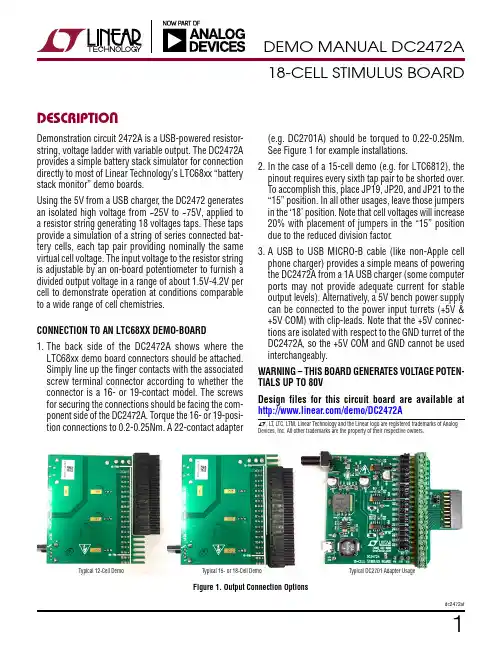
1dc2472afDESCRIPTION18-CELL STIMULUS BOARDDemonstration circuit 2472A is a USB-powered resistor-string, voltage ladder with variable output. The DC2472A provides a simple battery stack simulator for connection directly to most of Linear Technology’s LTC68xx “battery stack monitor” demo boards.Using the 5V from a USB charger , the DC2472 generates an isolated high voltage from ~25V to ~75V, applied to a resistor string generating 18 voltages taps. These taps provide a simulation of a string of series connected bat-tery cells, each tap pair providing nominally the same virtual cell voltage. The input voltage to the resistor string is adjustable by an on-board potentiometer to furnish a divided output voltage in a range of about 1.5V-4.2V per cell to demonstrate operation at conditions comparable to a wide range of cell chemistries.CONNECTION TO AN LTC68XX DEMO-BOARD1. The back side of the DC2472A shows where the LTC68xx demo board connectors should be attached. Simply line up the finger contacts with the associated screw terminal connector according to whether the connector is a 16- or 19-contact model. The screws for securing the connections should be facing the com-ponent side of the DC2472A. Torque the 16- or 19-posi-tion connections to 0.2-0.25Nm. A 22-contact adapterL , L T , L TC, L TM, Linear Technology and the Linear logo are registered trademarks of Analog Devices, Inc. All other trademarks are the property of their respective owners.(e.g. DC2701A) should be torqued to 0.22-0.25Nm. See Figure 1 for example installations.2. In the case of a 15-cell demo (e.g. for LTC6812), the pinout requires every sixth tap pair to be shorted over. To accomplish this, place JP19, JP20, and JP21 to the “15” position. In all other usages, leave those jumpers in the ‘18’ position. Note that cell voltages will increase 20% with placement of jumpers in the “15” position due to the reduced division factor .3. A USB to USB MICRO-B cable (like non-Apple cell phone charger) provides a simple means of powering the DC2472A from a 1A USB charger (some computer ports may not provide adequate current for stable output levels). Alternatively, a 5V bench power supply can be connected to the power input turrets (+5V & +5V COM) with clip-leads. Note that the +5V connec-tions are isolated with respect to the GND turret of the DC2472A, so the +5V COM and GND cannot be used interchangeably.WARNING – THIS BOARD GENERATES VOL TAGE POTEN-TIALS UP TO 80VDesign files for this circuit board are available at http://www.linear .com/demo/DC2472AFigure 1. Output Connection OptionsTypical DC2701 Adapter UsageTypical 12-Cell Demo Typical 15- or 18-Cell DemoQUICK START PROCEDURE1. Power up the DC2472A from the USB cable or bench supply.2. Once powered, the Blue LED1 should illuminate.3. Adjust potentiometer to provide a desired equivalent cell voltage as shown in Figure 2. Note that there will be some variation in voltages amongst “cells” due to component tolerances.4. Operate the LTC68xx demo as applicable. Note that resistor-string battery simulations (and DC2472A in particular) cannot generally generate currents suitable for properly demonstrating cell-balancing activity.5. Jumpers JP0 through JP18 may be used to discon-nect particular tap signals for demonstrating ‘open-wire’ scenarios. Relocating a particular jumper to the NC position will disconnect a cell path to simulate a broken connection.Figure 2. Cell Voltage Setting2dc2472afTHEORY OF OPERATIONThe DC2472A is a resistor-string voltage-divider ladder powered by a variable voltage. A block diagram is shown in Figure 3 and shows the key functional elements. The heart of the circuit is an LT8302 isolated flyback converter that produces both about 40V and 80V from a 5V source such as a USB charger. The source 5V does not share a galvanic connection to the equivalent cell-stack being simulated so that many units can be operated without any ‘ground-loop’ fault currents. The 40V powers an LT6650 amplifier whose 15V output is scaled by a potentiometer to create a variable voltage. The variable voltage is ampli-fied 5x by an LTC6090 op amp that is powered from the 80V. The LTC6090 drives an 18-tap resistor ladder to generate the equivalent series-connected cell voltages. Each tap pair includes a significant capacitance to pro-vide steady voltage in the presence of digitizing activity by the demo board that is being powered. The amplifier is decoupled and stabilized to operate with the capacitive load but can still quickly respond to larger load demands (i.e. the supply dynamics of the battery monitoring cir-cuit being powered). To also support 6-cell and 12-cell demonstrations, LTC6090 op amps also buffer 1/3 and 2/3 of the main LTC6090 voltage to provide stabilization at those points in the ladder that might have to supply current to a monitoring demo. To support a 15-cell demo, every 6th cell divider can be shorted over with a jumper (note that 15-cell demo circuits are designed to accept their cell inputs in a compatible pinout with 3 zero-volt cells). The lower voltage LTC6090 units include voltage reduction Zener diodes to minimize heating of the IC die if driving load current.Figure 3. Block Diagram of the DC2472A3dc2472afDEMONSTRATION BOARD IMPORTANT NOTICELinear Technology Corporation (LTC) provides the enclosed product(s) under the following AS IS conditions:This demonstration board (DEMO BOARD) kit being sold or provided by Linear Technology is intended for use for ENGINEERING DEVELOPMENT OR EVALUATION PURPOSES ONLY and is not provided by LTC for commercial use. As such, the DEMO BOARD herein may not be complete in terms of required design-, marketing-, and/or manufacturing-related protective considerations, including but not limited to product safety measures typically found in finished commercial goods. As a prototype, this product does not fall within the scope of the European Union directive on electromagnetic compatibility and therefore may or may not meet the technical requirements of the directive, or other regulations. If this evaluation kit does not meet the specifications recited in the DEMO BOARD manual the kit may be returned within 30 days from the date of delivery for a full refund. THE FOREGOING WARRANTY IS THE EXCLUSIVE WARRANTY MADE BY THE SELLER TO BUYER AND IS IN LIEU OF ALL OTHER WARRANTIES, EXPRESSED, IMPLIED, OR STATUTORY, INCLUDING ANY WARRANTY OF MERCHANTABILITY OR FITNESS FOR ANY PARTICULAR PURPOSE. EXCEPT TO THE EXTENT OF THIS INDEMNITY, NEITHER PARTY SHALL BE LIABLE TO THE OTHER FOR ANY INDIRECT, SPECIAL, INCIDENTAL, OR CONSEQUENTIAL DAMAGES.The user assumes all responsibility and liability for proper and safe handling of the goods. Further, the user releases LTC from all claims arising from the handling or use of the goods. Due to the open construction of the product, it is the user’s responsibility to take any and all appropriate precautions with regard to electrostatic discharge. Also be aware that the products herein may not be regulatory compliant or agency certified (FCC, UL, CE, etc.).No License is granted under any patent right or other intellectual property whatsoever. LTC assumes no liability for applications assistance, customer product design, software performance, or infringement of patents or any other intellectual property rights of any kind.LTC currently services a variety of customers for products around the world, and therefore this transaction is not exclusive.Please read the DEMO BOARD manual prior to handling the product. Persons handling this product must have electronics training and observe good laboratory practice standards. Common sense is encouraged.This notice contains important safety information about temperatures and voltages. For further safety concerns, please contact a LTC application engineer.Mailing Address:Linear Technology1630 McCarthy Blvd.Milpitas, CA 95035Copyright © 2004, Linear Technology Corporation。
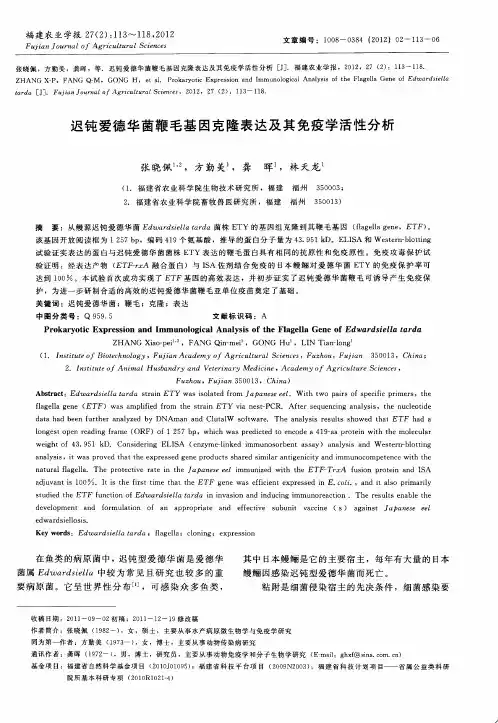
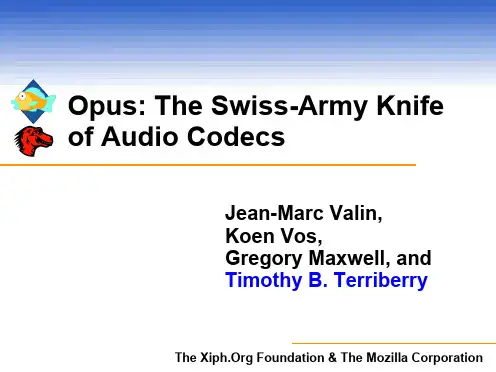

Color Digital Double Speed Megapixel CV-M7•2/3” progressive scan color CCD Camera•RGB primary mosaic filter (Bayer) for host based RGB decoding •1300 (h) x 1030 (v) 6.7 µm square pixels•8 bit video output (digitization via 10 bit A/D) as LVDS (EIA 644)•EIA 644 and Camera Link Versions available•Full 1030 lines frame readout in 1/24 second•Partial scan 1/2, 1/4, 1/8 for higher frame rate•S/N ratio >57 dB•Shutter 1/24 to 1/10,000 second in 10 steps•Edge pre-select and pulse width external trigger modes •Frame-delay readout•Unique smear reduction circuit•Pixel synchronized image transfer•Setup by RS 232C or switches•Windows 95/98/NT setup software Seri a l In t e r face Co n tr o l T o o lrs c232Progressive ScanThe leading manufacturer of high performance camera solutions<<<<<<<<>><<<<>>>><<<<>><<>><<<><><><><><<>><><><<>><><>Specifications for CV-M7SpecificationsCV-M7Visit our web site on JAI Corporation, Japan Phone +81 45 933 5400Fax +81 45 931 6142www.jai-corp.co.jpJAI A .S, DenmarkPhone +45 4457 8888Fax +45 4491 JAI UK Ltd., EnglandPhone +44 1442 879 669Fax +44 1442 879 JAI America Inc., USAPhone (Toll-Free) +1 877 472-5909Phone +1 949 472-5900Fax +1 949 JAI Vision OY, Finland Phone +358 9 8256220Fax +358 9 870 3345C o m p a n y a n d p r o d u c t n a m e s m e n t i o n e d i n t h i s d a t a s h e e t a r e t r a d e m a r k s o r r e g i s t e r e d t r a d e m a r k s o f t h e i r r e s p e c t i v e o w n e r s .J A I A .S c a n n o t b e h e l d r e s p o n s i b l e f o r a n y t e c h n i c a l o r t y p o g r a p h i c a l e r r o r s a n d r e s e r v e s t h e r i g h t t o m a k e c h a n g e s t o p r o d u c t s a n d d o c u m e n t a t i o n w i t h o u t p r i o r n o t i f i c a t i o n .Scanning system Progressive scan Pixel clock 40.49 MHzLine frequency 25.056 kHz. (1616 pixel clock/line)Frame rate 24 frames/sec. (1044 lines/frame)CCD sensor RGB color 2/3” IT CCD Sensing area 8.7 mm (h) x 6.9 mm (v)Picture elements 1300 (h) x 1030 (v) effective pixels Picture elements in video output Full:1280 (h) x 1024 (v). 24 fps 1/2 Partial:1280 (h) x 514 (v). 45 fps 1/4 Partial:1280 (h) x 250 (v). 79 fps 1/8 Partial:1280 (h) x 130 (v). 120 fpsCell size6.7 (h) x 6.7 (v) µm Center wavelength Blue 470 nm of spectral bands Green 540 nm Red 640 nmSensitivity on sensor 0.2 Lux (Max. gain, 50% video)S/N ratio>57 dB Video A/D conversion 10 bitVideo output options Digital 8 bit LVDS (EIA 644)Digital 10 bit Camera LinkGainManual Gain range 0 to + 12 dBGamma1.0Synchronization Int. X-tal.Trigger inputLVDS or TTL 2 – 5 V *Frame enable output LVDS */Camera Link Line enable output LVDS */Camera Link Pixel clock output LVDS */Camera LinkShutter 1/24, 1/50, 1/100, 1/200, 1/400, 1/800,1/1500, 1/3000, 1/5000, 1/10,000 sec.Partial scan Normal, 1/2, 1/4, 1/8Trigger modes Off, Edge pre-select, Pulse width controlReadout modes Normal, Smearless and Frame delayCamera setup Shutter, Trigger, Scanning,switches on rear Readout systemRS 232C control Shutter, Trigger, +/- slope, Scanning,Readout, Gain, Black levelOperating temperature -5°C to +45°CHumidity 20 – 80% non-condensingPower12V DC ± 10%. 5.5WLens mount C-mountDimensions 40 x 50 x 90 mm (HxWxD)Weight250 g* Polarity positive/negative by internal settingOrdering InformationCV-M7 Color Digital Double Speed Megapixel Progressive Scan CV-M7CL Color Digital Double Speed Megapixel Progressive ScanSpectral SensitivityConnection Description DimensionsDC-IN/TRIG.Pin1Ground 2+12V DC 3Ground 4Test 5Ground 6RXD input 7TXD output 8Ground 9FEN output 10TRIG in (TTL)11+12V DC 12GroundLVDS in-/outputsPin Signal 1, 14+/- Do Video out (LSB)2, 15+/- D1Video out 3, 16+/- D2Video out 4, 17+/- D3Video out 5, 18+/- D4Video out 6, 19+/- D5Video out 7, 20+/- D6Video out8, 21+/- D7Video out (MSB)9, 22+/- TRIGTrigger in 10, 23N.C.11, 24+/- LEN Line enable 12, 25+/- FEN Frame enable 13, 26+/- PCLK Pixel clockFront viewTrigger/Readout ModesSwitch Setting26 pin MDR connector 3M 10226-1A10JLDigital I/OLVDS in and outputs circuits NS.DS90C031/DS90C032For Camera Link pin configuration,see user manualSide viewBottom viewRear viewEXT. TRIGGERSHUTTER1/241/501/1001/2001/4001/8001/15001/30001/50001/10,000S e c o n d sNormal <> Smearless Local<> RS 232CF u l lO f f1/2 p a r t i a l p r e -SCANSMEAR-LESS CONTROLE d g e1/4 p a r t i a l P u l s e 1/8 p a r t i a l F r a m e OFFONEDGEPRE-SELECT PULSE WIDTHFRAME-DELAY READOUTTriggerTriggerTrigger Exposure shutter timeExposureExposure shutter time ReadoutReadoutReadout12345678910..depth1312614s e l e c t Wave Length (nm)R e l a t i v e r e s p o n s eHirose HR10A-10R-12P 31010732.05.01.3000d e l a yw i d t h。

Arnold featuresMemory-efficient, scalable raytracer rendering software helps artists render complex scenes quickly and easily.◆ See what's new (video: 2:31 min.)◆ Get feature details in the Arnold for Maya, Houdini, Cinema 4D, 3ds Max, or Katana user guidesSubsurface scatterHigh-performance ray-traced subsurface scattering eliminates the need to tune point clouds. Hair and furMemory-efficient ray-traced curve primitives help you create complex fur and hair renders.Motion blur3D motion blur interacts with shadows, volumes, indirect lighting, reflection, or refraction. Deformation motion blur and rotational motion are also supported. VolumesThe volumetric rendering system in Arnold can render effects such as smoke, clouds, fog, pyroclastic flow, and fire.InstancesArnold can more efficiently ray trace instances of many scene objects with transformation and material overrides. Subdivision and displacementArnold supports Catmull-Clark subdivision surfaces.OSL supportArnold now features support for Open Shading Language (OSL), an advanced shading language for Global Illumination renderers. Light Path ExpressionsLPEs give you power and flexibility to create Arbitrary Output Variables to help meet the needs of production.NEW|Adaptive samplingAdaptive sampling gives users another means of tuning images, allowing them to reduce render times without jeopardizing final image quality. NEW|Toon shaderAn advanced Toon shader is part of a non-photorealistic solution provided in combination with the Contour Filter.NEW|DenoisingTwo denoising solutions in Arnold offer flexibility by allowing users to use much lower-quality sampling settings. NEW|Material assignments and overrides Operators make it possible to override any part of a scene at render time and enable support for open standard framework such as MaterialX.NEW|Alembic proceduralA native Alembic procedural allows users to render Alembic files directly without any translation.NEW|Profiling API and structured statistics An extensive set of tools allow users to more easily identify performance issues and optimize rendering processes.Standard Surface shaderThis energy-saving, physically based uber shader helps produce a wide range of materials and looks. Standard Hair shaderThis physically based shader is built to render hair and fur, based on the d'Eon and Zinke models for specular and diffuse shading.Flexible and extensible APIIntegrate Arnold in external applications and create custom shaders, cameras, light filters, and output drivers. Stand-alone command-line rendererArnold has a native scene description format stored in human-readable text files. Easily edit, read, and write these files via the C/Python API.◆ See Arnold 5.1 release notesIntegrate Arnold into your pipeline•Free plug-ins provide a bridge to the Arnold renderer from within many popular 3D applications.•Arnold has supported plug-ins available for Maya, Houdini, Cinema 4D, 3ds Max, and Katana.•Arnold is fully customizable, with a powerful API to create custom rendering solutions.◆ See Arnold plug-ins。
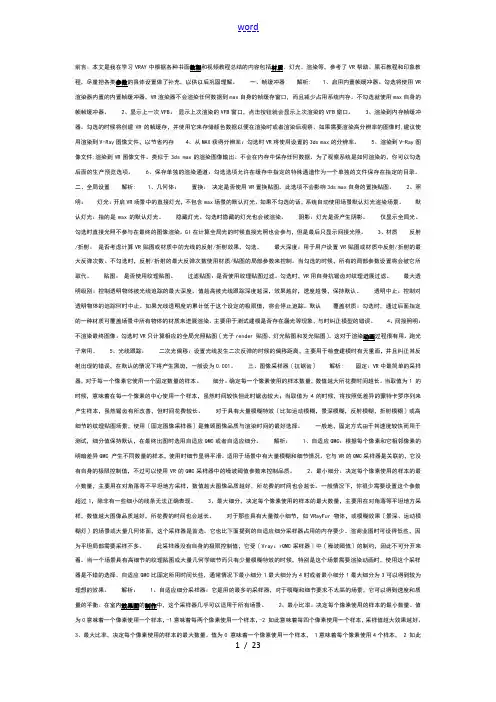
前言:本文是我在学习VRAY中根据各种书面教程和视频教程总结的内容包括材质、灯光、渲染等,参考了VR帮助、黑石教程和印象教程,尽量把各类参数的具体设置做了补充,以供以后巩固理解。
一、帧缓冲器解析: 1、启用内置帧缓冲器。
勾选将使用VR 渲染器内置的内置帧缓冲器,VR渲染器不会渲染任何数据到max自身的帧缓存窗口,而且减少占用系统内存。
不勾选就使用max自身的帧帧缓冲器。
2、显示上一次VFB:显示上次渲染的VFB窗口,点击按钮就会显示上次渲染的VFB窗口。
3、渲染到内存帧缓冲器。
勾选的时候将创建VR的帧缓存,并使用它来存储颜色数据以便在渲染时或者渲染后观察。
如果需要渲染高分辨率的图像时,建议使用渲染到V-Ray图像文件,以节省内存4、从MAX获得分辨率:勾选时VR将使用设置的3ds max的分辨率。
5、渲染到V-Ray图像文件:渲染到VR图像文件。
类似于3ds max的渲染图像输出。
不会在内存中保存任何数据。
为了观察系统是如何渲染的,你可以勾选后面的生产预览选项。
6、保存单独的渲染通道:勾选选项允许在缓存中指定的特殊通道作为一个单独的文件保存在指定的目录。
二、全局设置解析: 1、几何体:置换:决定是否使用VR置换贴图。
此选项不会影响3ds max自身的置换贴图。
2、照明:灯光:开启VR场景中的直接灯光,不包含max场景的默认灯光。
如果不勾选的话,系统自动使用场景默认灯光渲染场景。
默认灯光:指的是max的默认灯光。
隐藏灯光。
勾选时隐藏的灯光也会被渲染。
阴影:灯光是否产生阴影。
仅显示全局光。
勾选时直接光照不参与在最终的图像渲染。
GI在计算全局光的时候直接光照也会参与,但是最后只显示间接光照。
3、材质反射/折射:是否考虑计算VR贴图或材质中的光线的反射/折射效果,勾选。
最大深度:用于用户设置VR贴图或材质中反射/折射的最大反弹次数。
不勾选时,反射/折射的最大反弹次数使用材质/贴图的局部参数来控制。
当勾选的时候,所有的局部参数设置将会被它所取代。

absolute energy distribution 绝对能量分布abundance effect 丰度效应angular diameter—redshift relation 角径—红移关系asteroid astrometry 小行星天体测量bursting pulsar (GRO J1744-28 )暴态脉冲星Caliban 天卫十七canonical Big Bang 典型大爆炸Cepheid binary 造父双星CH anomaly CH 反常chromospheric plage 色球谱斑circumnuclear star-forming ring 核周产星环circumstellar astrophysics 星周天体物理CN anomaly CN 反常colliding-wind binary 星风互撞双星collisional de-excitation 碰撞去激发collisional ionization 碰撞电离collision line broadening 碰撞谱线致宽Compton loss 康普顿耗损continuous opacity 连续不透明度coronagraphic camera 日冕照相机coronal active region 日冕活动区cosmic-ray exposure age 宇宙线曝射法年龄count—magnitude relation 计数—星等关系Cousins color system 卡曾斯颜色系统dating method 纪年法DDO color system DDO 颜色系统deep sky object 深空天体deep sky phenomena 深空天象dense star cluster 稠密星团diagnostics 诊断法dissociative recombination 离解复合Doppler line broadening 多普勒谱线致宽epicyclic orbit 本轮轨道extragalactic background 河外背景extragalactic background radiation 河外背景辐射flare particle emission 耀斑粒子发射flare physics 耀斑物理Fm star Fm 星focal plane spectrometer 焦面分光计focusing X-ray telescope 聚焦X 射线望远镜Friedmann time 弗里德曼时间galactic chimney 星系通道Galactic chimney 银河系通道gas relention age 气体变异法年龄Gauss line profile 高斯谱线轮廓GCR (Galactic cosmic rays )银河系宇宙线Geneva color system 日内瓦颜色系统global oscilletion 全球振荡GW-Vir instability strip 室女GW 不稳定带Highly Advanced Laboratory for 〈HALCA〉通讯和天文高新空间Communications and Astronomy 实验室(HALCA )Hipparcos catalogue 依巴谷星表Hobby-Eberly Telescope (HET )〈HET〉大型拼镶镜面望远镜Hoyle—Narlikar cosmology 霍伊尔—纳里卡宇宙学Hubble Deep Field (HDF )哈勃深空区human space flight 载人空间飞行、人上天imaging spectrograph 成象摄谱仪infrared camera 红外照相机infrared luminosity 红外光度infrared polarimetry 红外偏振测量in-situ acceleration 原位加速intercept age 截距法年龄inverse Compton limit 逆康普顿极限isochron age 等龄线法年龄Johnson color system 约翰逊颜色系统K giant variable (KGV )K 型巨变星kinetic equilibrium 运动学平衡large-scale beam 大尺度射束large-scale jet 大尺度喷流limb polarization 临边偏振line-profile variable 谱线轮廓变星long term fluctuation 长期起伏Lorentz line profile 洛伦兹谱线轮廓magnetic arm 磁臂Mars globe 火星仪massive black hole 大质量黑洞mean extinction coefficient 平均消光系数mean luminosity density 平均光度密度microwave storm 微波噪暴Milli-Meter Array (MMA )〈MMA〉毫米波射电望远镜阵molecular maser 分子微波激射、分子脉泽moving atmosphere 动态大气neutrino loss rate 中微子耗损率non-linear astronomy 非线性天文non-standard model 非标准模型passband width 带宽P Cygni type star 天鹅P 型星Perseus chimney 英仙通道planetary companion 似行星伴天体plateau phase 平台阶段primordial abundance 原始丰度protobinary system 原双星proto-brown dwarf 原褐矮星quiescent galaxy 宁静星系radiation transport 辐射转移radio-intermediate quasar 中介射电类星体random peculiar motion 随机本动relative energy distribution 相对能量分布RGU color system RGU 颜色系统ringed barred galaxy 有环棒旋星系ringed barred spiral galaxy 有环棒旋星系rise phase 上升阶段Rossi X-ray Timing Explorer (RXTE )〈RXTE〉X 射线时变探测器RQPNMLK color system RQPNMLK 颜色系统Scheuer—Readhead hypothesis 朔伊尔—里德黑德假说Serpens molecular cloud 巨蛇分子云soft X-ray transient (SXT )软X 射线暂现源solar dynamo 太阳发电机solar global parameter 太阳整体参数solar neighbourhood 太阳附近空间spectral catalogue 光谱表spectral duplicity 光谱成双性star-formation process 产星过程star-forming phase 产星阶段Stroemgren color system 颜色系统Sub-Millimeter Array (SMA )〈SMA〉亚毫米波射电望远镜阵superassociation 超级星协supermassive black hole 特大质量黑洞supersoft X-ray source 超软X 射线源super-star cluster 超级星团Sycorax 天卫十七symbiotic recurrent nova 共生再发新星synchrotron loss 同步加速耗损time dilation 时间扩展tired-light model 光线老化宇宙模型tremendous outburst amplitude 巨爆幅tremendous outburst amplitude dwarf 巨爆幅矮新星nova (TOAD )Tycho catalogue 第谷星表UBV color system UBV 颜色系统UBVRI color system UBVRI 颜色系统ultraviolet luminosity 紫外光度unrestricted orbit 无限制性轨道uvby color system uvby 颜色系统VBLUW color system VBLUW 颜色系统V enus globe 金星仪Vilnius color system 维尔纽斯颜色系统Virgo galaxy cluster 室女星系团VLBA (Very Long Baseline Array )〈VLBA〉甚长基线射电望远镜阵V oigt line profile 佛克特谱线轮廓VRI color system VRI 颜色系统Walraven color system 沃尔拉文颜色系统waning crescent 残月waning gibbous 亏凸月waxing crescent 娥眉月waxing gibbous 盈凸月WBVR color system WBVR 颜色系统Wood color system 伍德颜色系统zodiacal light photometry 黄道光测光11-year solar cycle 11 年太阳周αCygni variable 天津四型变星δDoradus variable 剑鱼δ型变星Vainu Bappu Observatory 巴普天文台variable-velocity star 视向速度变星vectorial astrometry 矢量天体测量vector-point diagram 矢点图V ega 〈维佳〉行星际探测器V ega phenomenon 织女星现象velocity variable 视向速度变星V enera 〈金星〉号行星际探测器very strong-lined giant, VSL giant 甚强线巨星very strong-lined star, VSL star 甚强线星video astronomy 录象天文viewfinder 寻星镜Viking 〈海盗〉号火星探测器virial coefficient 位力系数virial equilibrium 位力平衡virial radius 位力半径virial temperature 位力温度virtual phase CCD 虚相CCDvisible arm 可见臂visible component 可见子星visual star 光学星VLT, Very Large Telescope 甚大望远镜void 巨洞V ondrak method 冯德拉克方法V oyager 〈旅行者〉号行星际探测器VSOP, VLBI Space Observatory 空间甚长基线干涉测量Programme 天文台计划wave-front sensor 波前传感器weak-line T Tauri star 弱线金牛T 型星Wesselink mass 韦塞林克质量WET, Whole Earth Telescope 全球望远镜WHT, William Herschel Telescope 〈赫歇尔〉望远镜wide-angle eyepiece 广角目镜wide binary galaxy 远距双重星系wide visual binary 远距目视双星Wild Duck cluster (M 11 )野鸭星团Wind 〈风〉太阳风和地球外空磁层探测器WIRE, Wide-field Infrared Explorer 〈WIRE〉广角红外探测器WIYN Telescope, Wisconsin-Indiana- 〈WIYN〉望远镜Yale-NOAO TelescopeWR nebula, Wolf-Rayet nebula WR 星云Wyoming Infrared Telescope 怀俄明红外望远镜xenobiology 外空生物学XMM, X-ray Mirror Mission X 射线成象望远镜X-ray corona X 射线冕X-ray eclipse X 射线食X-ray halo X 射线晕XTE, X-ray Timing Explorer X 射线计时探测器yellow straggler 黄离散星Yohkoh 〈阳光〉太阳探测器young stellar object (YSO )年轻恒星体ZAHB, zero-age horizontal branch 零龄水平支Zanstra temperature 赞斯特拉温度ZZ Ceti star 鲸鱼ZZ 型星γ-ray burster (GRB )γ射线暴源γ-ray line γ谱线γ-ray line astronomy γ谱线天文γ-ray line emission γ谱线发射ζAurigae binary 御夫ζ型双星ζAurigae variable 御夫ζ型变星TAMS, terminal-age main sequence 终龄主序Taurus molecular cloud (TMC )金牛分子云TDT, terrestrial dynamical time 地球力学时television guider 电视导星器television-type detector 电视型探测器Tenma 〈天马〉X 射线天文卫星terrestrial reference system 地球参考系tetrad 四元基thermal background 热背景辐射thermal background radiation 热背景辐射thermal pulse 热脉冲thermonuclear runaway 热核暴涨thick-disk population 厚盘族thinned CCD 薄型CCDthird light 第三光源time-signal station 时号台timing age 计时年龄tomograph 三维结构图toner 调色剂torquetum 赤基黄道仪TRACE, Transition Region and Coronal 〈TRACE〉太阳过渡区和日冕Explorer 探测器tracker 跟踪器transfer efficiency 转移效率transition region line 过渡区谱线trans-Nepturnian object 海外天体Trapezium cluster 猎户四边形星团triad 三元基tri-dimensional spectroscopy 三维分光triquetum 三角仪tuning-fork diagram 音叉图turnoff age 拐点年龄turnoff mass 拐点质量two-dimensional photometry 二维测光two-dimensional spectroscopy 二维分光UKIRT, UK Infrared Telescope Facility 联合王国红外望远镜UKST, UK Schmidt Telescope 联合王国施密特望远镜ultracompact H Ⅱregion 超致密电离氢区ultradeep-field observation 特深天区观测ultraluminous galaxy 超高光度星系ultrametal-poor star 特贫金属星Ulysses 〈尤利西斯〉太阳探测器unseen component 未见子星upper tangent arc 上正切晕弧unnumbered asteroid 未编号小行星Uranian ring 天王星环Ursa Major group 大熊星群Ursa Minorids 小熊流星群Sagittarius dwarf 人马矮星系Sagittarius dwarf galaxy 人马矮星系Sagittarius galaxy 人马星系Saha equation 沙哈方程Sakigake 〈先驱〉空间探测器Saturn-crossing asteroid 越土小行星Saturnian ringlet 土星细环Saturnshine 土星反照scroll 卷滚Sculptor group 玉夫星系群Sculptor Supercluster 玉夫超星系团Sculptor void 玉夫巨洞secondary crater 次级陨击坑secondary resonance 次共振secular evolution 长期演化secular resonance 长期共振seeing management 视宁度控管segregation 层化selenogony 月球起源学separatrice 分界sequential estimation 序贯估计sequential processing 序贯处理serendipitous X-ray source 偶遇X 射线源serendipitous γ-ray source 偶遇γ射线源Serrurier truss 赛路里桁架shell galaxy 壳星系shepherd satellite 牧羊犬卫星shock temperature 激波温度silicon target vidicon 硅靶光导摄象管single-arc method 单弧法SIRTF, Space Infrared Telescope 空间红外望远镜Facilityslitless spectroscopy 无缝分光slit spectroscopy 有缝分光slow pulsar 慢转脉冲星SMM, Solar Maximum MIssion 太阳极大使者SMT, Submillimeter Telescope 亚毫米波望远镜SOFIA, Stratospheric Observatory for 〈索菲雅〉机载红外望远镜Infrared Astronomysoft γ-ray burst repeater 软γ暴复现源soft γrepeater (SGR )软γ射线复现源SOHO, Solar and Heliospheric 〈索贺〉太阳和太阳风层探测器Observatorysolar circle 太阳圈solar oscillation 太阳振荡solar pulsation 太阳脉动solar-radiation pressure 太阳辐射压solar-terrestrial environment 日地环境solitary 孤子性soliton star 孤子星South Galactic Cap 南银冠South Galactic Pole 南银极space density profile 空间密度轮廓space geodesy 空间大地测量space geodynamics 空间地球动力学Spacelab 空间实验室spatial mass segregation 空间质量分层speckle masking 斑点掩模speckle photometry 斑点测光speckle spectroscopy 斑点分光spectral comparator 比长仪spectrophotometric distance 分光光度距离spectrophotometric standard 分光光度标准星spectroscopic period 分光周期specular density 定向密度spherical dwarf 椭球矮星系spin evolution 自旋演化spin period 自旋周期spin phase 自旋相位spiral 旋涡星系spiral arm tracer 示臂天体Spoerer minimum 斯珀勒极小spotted star 富黑子恒星SST, Spectroscopic Survey Telescope 分光巡天望远镜standard radial-velocity star 视向速度标准星standard rotational-velocity star 自转速度标准星standard velocity star 视向速度标准星starburst 星暴starburst galaxy 星暴星系starburst nucleus 星暴star complex 恒星复合体star-formation activity 产星活动star-formation burst 产星暴star-formation efficiency (SFE )产星效率star-formation rate 产星率star-formation region 产星区star-forming region 产星区starpatch 星斑static property 静态特性statistical orbit-determination 统计定轨理论theorysteep-spectrum radio quasar 陡谱射电类星体stellar environment 恒星环境stellar halo 恒星晕stellar jet 恒星喷流stellar speedometer 恒星视向速度仪stellar seismology 星震学Stokes polarimetry 斯托克斯偏振测量strange attractor 奇异吸引体strange star 奇异星sub-arcsec radio astronomy 亚角秒射电天文学Subaru Telescope 昴星望远镜subcluster 次团subclustering 次成团subdwarf B star B 型亚矮星subdwarf O star O 型亚矮星subgiant branch 亚巨星支submilliarcsecond optical astrometry 亚毫角秒光波天体测量submillimeter astronomy 亚毫米波天文submillimeter observatory 亚毫米波天文台submillimeter photometry 亚毫米波测光submillimeter space astronomy 亚毫米波空间天文submillimeter telescope 亚毫米波望远镜submillisecond optical pulsar 亚毫秒光学脉冲星submillisecond pulsar 亚毫秒脉冲星submillisecond radio pulsar 亚毫秒射电脉冲星substellar object 亚恒星天体subsynchronism 亚同步subsynchronous rotation 亚同步自转Sunflower galaxy (M 63 )葵花星系sungrazer comet 掠日彗星supercluster 超星团; 超星系团supergalactic streamer 超星系流状结构supergiant molecular cloud (SGMC )超巨分子云superhump 长驼峰superhumper 长驼峰星supermaximum 长极大supernova rate 超新星频数、超新星出现率supernova shock 超新星激波superoutburst 长爆发superwind galaxy 超级风星系supporting system 支承系统surface activity 表面活动surface-brightness profile 面亮度轮廓surface-channel CCD 表面型CCDSU Ursae Majoris star 大熊SU 型星SW AS, Submillimeter Wave Astronomy 亚毫米波天文卫星Satallitesymbiotic binary 共生双星symbiotic Mira 共生刍藁symbiotic nova 共生新星synthetic-aperture radar 综合孔径雷达systemic velocity 质心速度radial pulsator 径向脉动星radial-velocity orbit 分光解radial-velocity reference star 视向速度参考星radial-velocity standard star 视向速度标准星radial-velocity survey 视向速度巡天radio arm 射电臂radio counterpart 射电对应体radio loud quasar 强射电类星体radio observation 射电观测radio picture 射电图radio pollution 射电污染radio supernova 射电超新星rapid burster 快暴源rapidly oscillating Ap star 快速振荡Ap 星readout 读出readout noise 读出噪声recycled pulsar 再生脉冲星reddened galaxy 红化星系reddened object 红化天体reddened quasar 红化类星体red horizontal branch (RHB )红水平分支red nebulous object (RNO )红色云状体Red Rectangle nebula 红矩形星云redshift survey 红移巡天red straggler 红离散星reflex motion 反映运动regression period 退行周期regular cluster 规则星团; 规则星系团relaxation effect 弛豫效应reset 清零resonance overlap theory 共振重叠理论return-beam tube 回束摄象管richness parameter 富度参数Ring nebula (M 57、NGC 6720 )环状星云ring-plane crossing 环面穿越Rosalind 天卫十三ROSAT, Roentgensatellit 〈ROSAT〉天文卫星Rosette Molecular Cloud (RMC )玫瑰分子云Rossby number 罗斯贝数rotating variable 自转变星rotational evolution 自转演化rotational inclination 自转轴倾角rotational modulation 自转调制rotational period 自转周期rotational phase 自转相位rotational pole 自转极rotational velocity 自转速度rotation frequency 自转频率rotation phase 自转相位rotation rate 自转速率rubber second 负闰秒rubidium-strontium dating 铷锶计年pan 摇镜头parry arc 彩晕弧partial-eclipse solution 偏食解particle astrophysics 粒子天体物理path of annularity 环食带path of totality 全食带PDS, photo-digitizing system、PDS、数字图象仪、photometric data system 测光数据仪penetrative convection 贯穿对流pentaprism test 五棱镜检验percolation 渗流periapse 近质心点periapse distance 近质心距periapsis distance 近拱距perigalactic distance 近银心距perigalacticon 近银心点perimartian 近火点period gap 周期空隙period-luminosity-colour relation 周光色关系PG 1159 star PG 1159 恒星photoflo 去渍剂photographic spectroscopy 照相分光photometric accuracy 测光精度photometric error 测光误差photometric night 测光夜photometric standard star 测光标准星photospheric abundance 光球丰度photospheric activity 光球活动photospheric line 光球谱线planetary biology 行星生物学planetary geology 行星地质学Pleiad 昴团星plerion 类蟹遗迹plerionic remnant 类蟹遗迹plerionic supernova remnant 类蟹超新星遗迹plumbicon 氧化铅光导摄象管pluton 类冥行星p-mode p 模、压力模pointimg accuracy 指向精度point spread function 点扩散函数polarimetric standard star 偏振标准星polarization standard star 偏振标准星polar-ring galaxy 极环星系Portia 天卫十二post AGB star AGB 后恒星post-core-collapse cluster 核心坍缩后星团post-coronal region 冕外区post-main-sequence star 主序后星post red-supergiant 红超巨后星post starburst galaxy 星暴后星系post T Tauri star 金牛T 后星potassium-argon dating 钾氩计年precataclysmic binary 激变前双星precataclysmic variable 激变前变星preceding limb 西边缘、前导边缘precessing-disk model 进动盘模型precession globe 岁差仪precession period 进动周期preflash 预照光pre-main-sequence spectroscopic 主序前分光双星binarypre-planetary disk 前行星盘pre-white dwarf 白矮前身星primary crater 初级陨击坑primordial binary 原始双星principle of mediocrity 折衷原则progenitor 前身星; 前身天体progenitor star 前身星projected density profile 投影密度轮廓proper-motion membership 自行成员星proper reference frame 固有参考架proper reference system 固有参考系proplyd 原行星盘proto-binary 原双星proto-cluster 原星团proto-cluster of galaxies 原星系团proto-earth 原地球proto-galactic cloud 原星系云proto-galactic object 原星系天体proto-Galaxy 原银河系proto-globular cluster 原球状星团proto-Jupiter 原木星proto-planet 原行星proto-planetary disk 原行星盘proto-planetary system 原行星系proto-shell star 原气壳星proto-sun 原太阳pseudo body-fixed system 准地固坐标系Puck 天卫十五pulsar time scale 脉冲星时标pulsation axis 脉动对称轴pulsation equation 脉动方程pulsation frequency 脉动频率pulsation phase 脉动阶段pulsation pole 脉动极pulse light curve 脉冲光变曲线pyrometry 高温测量QPO, quasi-periodic oscillation 似周期振荡quantum cosmology 量子宇宙学quantum universe 量子宇宙quasar astronomy 类星体天文quiescence 宁静态naked-eye variable star 肉眼变星naked T Tauri star 显露金牛T 型星narrow-line radio galaxy (NLRG )窄线射电星系Nasmyth spectrograph 内氏焦点摄谱仪natural reference frame 自然参考架natural refenence system 自然参考系natural seeing 自然视宁度near-contact binary 接近相接双星near-earth asteroid 近地小行星near-earth asteroid belt 近地小行星带near-earth comet 近地彗星NEO, near-earth object 近地天体neon nova 氖新星Nepturian ring 海王星环neutrino astrophysics 中微子天文NNTT, National New Technology Telescope国立新技术望远镜NOAO, National Optical Astronomical 国立光学天文台Observatoriesnocturnal 夜间定时仪nodal precession 交点进动nodal regression 交点退行non-destroy readout (NDRO )无破坏读出nonlinear infall mode 非线性下落模型nonlinear stability 非线性稳定性nonnucleated dwarf elliptical 无核矮椭圆星系nonnucleated dwarf galaxy 无核矮星系nonpotentiality 非势场性nonredundant masking 非过剩遮幅成象nonthermal radio halo 非热射电晕normal tail 正常彗尾North Galactic Cap 北银冠NOT, Nordic Optical Telescope 北欧光学望远镜nova rate 新星频数、新星出现率NTT, New Technology Telescope 新技术望远镜nucleated dwarf elliptical 有核矮椭圆星系nucleated dwarf galaxy 有核矮星系number density profile 数密度轮廓numbered asteroid 编号小行星oblique pulsator 斜脉动星observational cosmology 观测宇宙学observational dispersion 观测弥散度observational material 观测资料observing season 观测季occultation band 掩带O-Ne-Mg white dwarf 氧氖镁白矮星one-parameter method 单参数法on-line data handling 联机数据处理on-line filtering 联机滤波open cluster of galaxies 疏散星系团Ophelia 天卫七optical aperture-synthesis imaging 光波综合孔径成象optical arm 光学臂optical disk 光学盘optical light 可见光optical luminosity function 光学光度函数optically visible object 光学可见天体optical picture 光学图optical spectroscopy 光波分光orbital circularization 轨道圆化orbital eccentricity 轨道偏心率orbital evolution 轨道演化orbital frequency 轨道频率orbital inclination 轨道倾角orbit plane 轨道面order region 有序区organon parallacticon 星位尺Orion association 猎户星协orrery 太阳系仪orthogonal transformation 正交变换oscillation phase 振动相位outer asteroid belt 外小行星带outer-belt asteroid 外带小行星outer halo cluster 外晕族星团outside-eclipse variation 食外变光overshoot 超射OVV quasar, optically violently OVV 类星体variable quasar、optically violent variablevquasaroxygen sequence 氧序Kalman filter 卡尔曼滤波器KAO, Kuiper Air-borne Observatory 〈柯伊伯〉机载望远镜Keck ⅠTelescope 凯克Ⅰ望远镜Keck ⅡTelescope 凯克Ⅱ望远镜Kuiper belt 柯伊伯带Kuiper-belt object 柯伊伯带天体Kuiper disk 柯伊伯盘LAMOST, Large Multi-Object Fibre 大型多天体分光望远镜Spectroscopic TelescopeLaplacian plane 拉普拉斯平面late cluster 晚型星系团LBT, Large Binocular Telescope 〈LBT〉大型双筒望远镜lead oxide vidicon 氧化铅光导摄象管Leo Triplet 狮子三重星系LEST, Large Earth-based Solar 〈LEST〉大型地基太阳望远镜Telescopelevel-Ⅰcivilization Ⅰ级文明level-Ⅱcivilization Ⅱ级文明level-Ⅲcivilization Ⅲ级文明Leverrier ring 勒威耶环Liapunov characteristic number 李雅普诺夫特征数(LCN )light crown 轻冕玻璃light echo 回光light-gathering aperture 聚光孔径light pollution 光污染light sensation 光感line image sensor 线成象敏感器line locking 线锁line-ratio method 谱线比法Liner, low ionization nuclear 低电离核区emission-line regionline spread function 线扩散函数LMT, Large Millimeter Telescope 〈LMT〉大型毫米波望远镜local galaxy 局域星系local inertial frame 局域惯性架local inertial system 局域惯性系local object 局域天体local star 局域恒星look-up table (LUT )对照表low-mass X-ray binary 小质量X 射线双星low-metallicity cluster 低金属度星团;低金属度星系团low-resolution spectrograph 低分辨摄谱仪low-resolution spectroscopy 低分辨分光low - z 小红移luminosity mass 光度质量luminosity segregation 光度层化luminous blue variable 高光度蓝变星lunar atmosphere 月球大气lunar chiaroscuro 月相图Lunar Prospector 〈月球勘探者〉Ly-αforest 莱曼-α森林MACHO (massive compact halo 晕族大质量致密天体object )Magellan 〈麦哲伦〉金星探测器Magellan Telescope 〈麦哲伦〉望远镜magnetic canopy 磁蓬magnetic cataclysmic variable 磁激变变星magnetic curve 磁变曲线magnetic obliquity 磁夹角magnetic period 磁变周期magnetic phase 磁变相位magnitude range 星等范围main asteroid belt 主小行星带main-belt asteroid 主带小行星main resonance 主共振main-sequence band 主序带Mars-crossing asteroid 越火小行星Mars Pathfinder 火星探路者mass loss rate 质量损失率mass segregation 质量层化Mayall Telescope 梅奥尔望远镜Mclntosh classification 麦金托什分类McMullan camera 麦克马伦电子照相机mean motion resonance 平均运动共振membership of cluster of galaxies 星系团成员membership of star cluster 星团成员merge 并合merger 并合星系; 并合恒星merging galaxy 并合星系merging star 并合恒星mesogranulation 中米粒组织mesogranule 中米粒metallicity 金属度metallicity gradient 金属度梯度metal-poor cluster 贫金属星团metal-rich cluster 富金属星团MGS, Mars Global Surveyor 火星环球勘测者micro-arcsec astrometry 微角秒天体测量microchannel electron multiplier 微通道电子倍增管microflare 微耀斑microgravitational lens 微引力透镜microgravitational lensing 微引力透镜效应microturbulent velocity 微湍速度millimeter-wave astronomy 毫米波天文millisecond pulsar 毫秒脉冲星minimum mass 质量下限minimum variance 最小方差mixed-polarity magnetic field 极性混合磁场MMT, Multiple-Mirror Telescope 多镜面望远镜moderate-resolution spectrograph 中分辨摄谱仪moderate-resolution spectroscopy 中分辨分光modified isochrone method 改进等龄线法molecular outflow 外向分子流molecular shock 分子激波monolithic-mirror telescope 单镜面望远镜moom 行星环卫星moon-crossing asteroid 越月小行星morphological astronomy 形态天文morphology segregation 形态层化MSSSO, Mount Stromlo and Siding 斯特朗洛山和赛丁泉天文台Spring Observatorymultichannel astrometric photometer 多通道天测光度计(MAP )multi-object spectroscopy 多天体分光multiple-arc method 复弧法multiple redshift 多重红移multiple system 多重星系multi-wavelength astronomy 多波段天文multi-wavelength astrophysics 多波段天体物理Ida 艾达(小行星243号)IEH, International Extreme Ultraviolet 〈IEH〉国际极紫外飞行器HitchhikerIERS, International Earth Rotation 国际地球自转服务Serviceimage deconvolution 图象消旋image degradation 星象劣化image dissector 析象管image distoration 星象复原image photon counting system 成象光子计数系统image sharpening 星象增锐image spread 星象扩散度imaging polarimetry 成象偏振测量imaging spectrophotometry 成象分光光度测量immersed echelle 浸渍阶梯光栅impulsive solar flare 脉冲太阳耀斑infralateral arc 外侧晕弧infrared CCD 红外CCDinfrared corona 红外冕infrared helioseismology 红外日震学infrared index 红外infrared observatory 红外天文台infrared spectroscopy 红外分光initial earth 初始地球initial mass distribution 初始质量分布initial planet 初始行星initial star 初始恒星initial sun 初始太阳inner coma 内彗发inner halo cluster 内晕族星团integrability 可积性Integral Sign galaxy (UGC 3697 )积分号星系integrated diode array (IDA )集成二极管阵intensified CCD 增强CCDIntercosmos 〈国际宇宙〉天文卫星interline transfer 行间转移intermediate parent body 中间母体intermediate polar 中介偏振星international atomic time 国际原子时International Celestial Reference 国际天球参考系Frame (ICRF )intraday variation 快速变化intranetwork element 网内元intrinsic dispersion 内廪弥散度ion spot 离子斑IPCS, Image Photon Counting System 图象光子计数器IRIS, Infrared Imager / Spectrograph 红外成象器/摄谱仪IRPS, Infrared Photometer / Spectro- 红外光度计/分光计meterirregular cluster 不规则星团; 不规则星系团IRTF, NASA Infrared Telescope 〈IRTF〉美国宇航局红外Facility 望远镜IRTS, Infrared Telescope in Space 〈IRTS〉空间红外望远镜ISO, Infrared Space Observatory 〈ISO〉红外空间天文台isochrone method 等龄线法IUE, International Ultraviolet 〈IUE〉国际紫外探测器ExplorerJewel Box (NGC 4755 )宝盒星团Jovian magnetosphere 木星磁层Jovian ring 木星环Jovian ringlet 木星细环Jovian seismology 木震学jovicentric orbit 木心轨道J-type star J 型星Juliet 天卫十一Jupiter-crossing asteroid 越木小行星Galactic aggregate 银河星集Galactic astronomy 银河系天文Galactic bar 银河系棒galactic bar 星系棒galactic cannibalism 星系吞食galactic content 星系成分galactic merge 星系并合galactic pericentre 近银心点Galactocentric distance 银心距galaxy cluster 星系团Galle ring 伽勒环Galilean transformation 伽利略变换Galileo 〈伽利略〉木星探测器gas-dust complex 气尘复合体Genesis rock 创世岩Gemini Telescope 大型双子望远镜Geoalert, Geophysical Alert Broadcast 地球物理警报广播giant granulation 巨米粒组织giant granule 巨米粒giant radio pulse 巨射电脉冲Ginga 〈星系〉X 射线天文卫星Giotto 〈乔托〉空间探测器glassceramic 微晶玻璃glitch activity 自转突变活动global change 全球变化global sensitivity 全局灵敏度GMC, giant molecular cloud 巨分子云g-mode g 模、重力模gold spot 金斑病GONG, Global Oscillation Network 太阳全球振荡监测网GroupGPS, global positioning system 全球定位系统Granat 〈石榴〉号天文卫星grand design spiral 宏象旋涡星系gravitational astronomy 引力天文gravitational lensing 引力透镜效应gravitational micro-lensing 微引力透镜效应great attractor 巨引源Great Dark Spot 大暗斑Great White Spot 大白斑grism 棱栅GRO, Gamma-Ray Observatory γ射线天文台guidscope 导星镜GW Virginis star 室女GW 型星habitable planet 可居住行星Hakucho 〈天鹅〉X 射线天文卫星Hale Telescope 海尔望远镜halo dwarf 晕族矮星halo globular cluster 晕族球状星团Hanle effect 汉勒效应hard X-ray source 硬X 射线源Hay spot 哈伊斑HEAO, High-Energy Astronomical 〈HEAO〉高能天文台Observatoryheavy-element star 重元素星heiligenschein 灵光Helene 土卫十二helicity 螺度heliocentric radial velocity 日心视向速度heliomagnetosphere 日球磁层helioseismology 日震学helium abundance 氦丰度helium main-sequence 氦主序helium-strong star 强氦线星helium white dwarf 氦白矮星Helix galaxy (NGC 2685 )螺旋星系Herbig Ae star 赫比格Ae 型星Herbig Be star 赫比格Be 型星Herbig-Haro flow 赫比格-阿罗流Herbig-Haro shock wave 赫比格-阿罗激波hidden magnetic flux 隐磁流high-field pulsar 强磁场脉冲星highly polarized quasar (HPQ )高偏振类星体high-mass X-ray binary 大质量X 射线双星high-metallicity cluster 高金属度星团;高金属度星系团high-resolution spectrograph 高分辨摄谱仪high-resolution spectroscopy 高分辨分光high - z 大红移Hinotori 〈火鸟〉太阳探测器Hipparcos, High Precision Parallax 〈依巴谷〉卫星Collecting SatelliteHipparcos and Tycho Catalogues 〈依巴谷〉和〈第谷〉星表holographic grating 全息光栅Hooker Telescope 胡克望远镜host galaxy 寄主星系hot R Coronae Borealis star 高温北冕R 型星HST, Hubble Space Telescope 哈勃空间望远镜Hubble age 哈勃年龄Hubble distance 哈勃距离Hubble parameter 哈勃参数Hubble velocity 哈勃速度hump cepheid 驼峰造父变星Hyad 毕团星hybrid-chromosphere star 混合色球星hybrid star 混合大气星hydrogen-deficient star 缺氢星hydrogenous atmosphere 氢型大气hypergiant 特超巨星Eagle nebula (M 16 )鹰状星云earty cluster 早型星系团early earth 早期地球early planet 早期行星early-stage star 演化早期星early stellar evolution 恒星早期演化early sun 早期太阳earth-approaching asteroid 近地小行星earth-approaching comet 近地彗星earth-approaching object 近地天体earth-crossing asteroid 越地小行星earth-crossing comet 越地彗星earth-crossing object 越地天体earth orientation parameter 地球定向参数earth rotation parameter 地球自转参数eccentric-disk model 偏心盘模型effect of relaxation 弛豫效应Egg nebula (AFGL 2688 )蛋状星云electronographic photometry 电子照相测光elemental abundance 元素丰度elliptical 椭圆星系elliptical dwarf 椭圆矮星系emulated data 仿真数据emulation 仿真encounter-type orbit 交会型轨道enhanced network 增强网络equatorial rotational velocity 赤道自转速度equatorium 行星定位仪equipartition of kinetic energy 动能均分eruptive period 爆发周期Eskimo nebula (NGC 2392 )爱斯基摩星云estimated accuracy 估计精度estimation theory 估计理论EUVE, Extreme Ultraviolet Explorer 〈EUVE〉极紫外探测器Exclamation Mark galaxy 惊叹号星系Exosat 〈Exosat〉欧洲X 射线天文卫星extended Kalman filter 扩充卡尔曼滤波器extragalactic jet 河外喷流extragalactic radio astronomy 河外射电天文extrasolar planet 太阳系外行星extrasolar planetary system 太阳系外行星系extraterrestrial intelligence 地外智慧生物extreme helium star 极端氦星Fabry-Perot imaging spectrograph 法布里-珀罗成象摄谱仪Fabry-Perot interferometry 法布里-珀罗干涉测量Fabry-Perot spectrograph 法布里-珀罗摄谱仪face-on galaxy 正向星系face-on spiral 正向旋涡星系facility seeing 人为视宁度fall 见落陨星fast pulsar 快转脉冲星fat zero 胖零Fermi normal coordinate system 费米标准坐标系Fermi-Walker transportation 费米-沃克移动fibre spectroscopy 光纤分光field centre 场中心field galaxy 场星系field pulsar 场脉冲星filter photography 滤光片照相观测filter wheel 滤光片转盘find 发见陨星finder chart 证认图finderscope 寻星镜first-ascent giant branch 初升巨星支first giant branch 初升巨星支flare puff 耀斑喷焰flat field 平场flat field correction 平场改正flat fielding 平场处理flat-spectrum radio quasar 平谱射电类星体flux standard 流量标准星flux-tube dynamics 磁流管动力学f-mode f 模、基本模following limb 东边缘、后随边缘foreground galaxy 前景星系foreground galaxy cluster 前景星系团formal accuracy 形式精度Foucaultgram 傅科检验图样Foucault knife-edge test 傅科刀口检验fourth cosmic velocity 第四宇宙速度frame transfer 帧转移Fresnel lens 菲涅尔透镜fuzz 展云CAMC, Carlsberg Automatic Meridian 卡尔斯伯格自动子午环Circlecannibalism 吞食cannibalized galaxy 被吞星系cannibalizing galaxy 吞食星系。

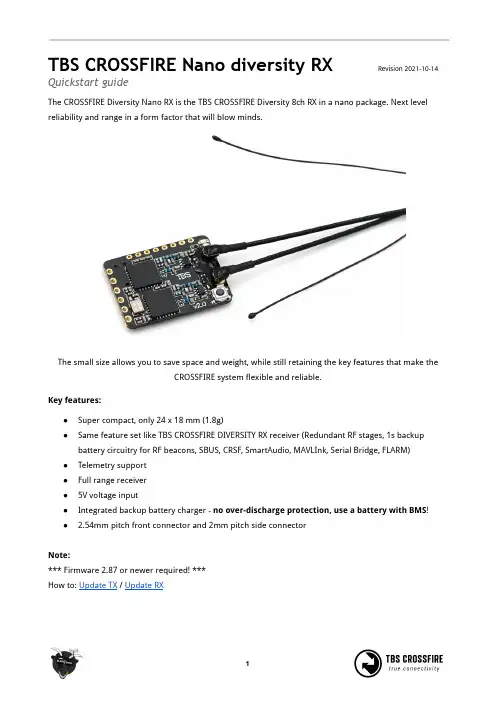
TBS CROSSFIRE Nano diversity RX Revision 2021-10-14 Quickstart guideThe CROSSFIRE Diversity Nano RX is the TBS CROSSFIRE Diversity 8ch RX in a nano package. Next level reliability and range in a form factor that will blow minds.The small size allows you to save space and weight, while still retaining the key features that make theCROSSFIRE system flexible and reliable.Key features:●Super compact, only 24 x 18 mm (1.8g)●Same feature set like TBS CROSSFIRE DIVERSITY RX receiver (Redundant RF stages, 1s backupbattery circuitry for RF beacons, SBUS, CRSF, SmartAudio, MAVLInk, Serial Bridge, FLARM)●Telemetry support●Full range receiver●5V voltage input●Integrated backup battery charger -no over-discharge protection, use a battery with BMS!● 2.54mm pitch front connector and 2mm pitch side connectorNote:*** Firmware 2.87 or newer required! ***How to:Update TX/Update RXWiring receiverThe receiver does not come with any connectors on-board, this is intending to allow for flexible and more varied setups, i.e. it is easier to add a connector than to remove a pre-soldered one.Use normal servo-wires to either connect directly to the soldering pads/vias or use a 2.54mm pin header to mount it to a motherboard.Output CH1 to CH8 are multi-purpose and support the below functionality.Receiver pin Output type Diversity RX (Nano)Default value1PWM CH1 (PWM Ch1 to 12), PPM, RSSI, LQ, RSSI/LQ, CRSF TX PWM Ch. 12PWM CH2 (PWM Ch1 to 12), RSSI, LQ, RSSI/LQ, CRSF RX PWM Ch. 2PWM Ch. 3 3PWM CH3 (PWM Ch1 to 12), RSSI, LQ, RSSI/LQ, SBUS,n.i.SBUS, Serial TX, MAVLink TX, CRSF TX, DSMX, SmartAudio4PWM CH4 (PWM Ch1 to 12), RSSI, LQ, RSSI/LQ, Serial RX,PWM Ch. 4MAVLink RX, CRSF RX5PWM CH5 (PWM Ch1 to 12), RSSI, LQ, RSSI/LQ, Serial RTS PWM Ch. 56PWM CH6 (PWM Ch1 to 12), RSSI, LQ, RSSI/LQ, Serial RTS PWM Ch. 6PWM Ch. 7 7PWM CH7 (PWM Ch1 to 12), RSSI, LQ, RSSI/LQ, Serial RX,MAVLink RX, CRSF RXPWM Ch. 8 8PWM CH8 (PWM Ch1 to 12), RSSI, LQ, RSSI/LQ, SBUS,n.i.SBUS, Serial TX, MAVLink TX, CRSF TX, DSMX, SmartAudioReceiver LED ColorReceiver LED indicators DescriptionSolid green▀▀▀The link is up and running OKSolid red▀▀▀No packages received from the transmitter and receiver is infailsafe modeSlow red blinking▀▀▀The receiver needs an update, confirmation on the TX is required Slow green blinking▀▀▀The receiver is in binding mode/ Find mode activeFast green blinking■■■■Receiver bootloader active or firmware upgrade runningGreen is flashing███diversity RX is in Find-mode (up to 1 min. delay between flashing) Double green blinking■■■■Authentication running/ error. Rebind your receiver if it remainslonger than a few secondsRed/ Green blinking, any pattern■■■■firmware issue, run the emergency update for the receiver, then rebind itLiPo LED indicator StatusRed blinking▀▀▀Backup battery is charging Solid red▀▀▀Backup battery is fully chargedAntennaThe antennas use a U.FL connector. Connect the antenna with the U.FL connector to the socket on the receiver. To ensure that it does not disconnect or unseat, run the coax cable across the receiver board over to the servo channel end and secure it with the heat shrink tubing.BindingMake sure you have updated the firmware to at least version 2.87! The binding is super simple.1.Power up the TBS CROSSFIRE transmitter2.On the standard transmitter, enter the configuration menu by pressing and holding the joystick for3 seconds, select “General” and “Binding” - a message “Binding” will start blinking, waiting for thereceiver. On the micro transmitter, a short press on the button will initiate binding mode.3.Power up the receiver (without pressing the Bind button!), if your receiver has not been previouslybound, it will automatically bind. Otherwise, press and release the “BIND” button on the receiver to initiate binding. You need to push the button within one minute to avoid the timeout. If thestatus LED starts flashing slowly the receiver has switched successfully to bind mode.4.Within a few seconds, the process will finish with a “Binding complete” message on the standardtransmitter, or a solid green LED on the micro transmitter. If it doesn’t bind, please verify that your firmware is to the newest version on both the receiver and the transmitter. You may want to bind through the LUA script on the Micro TX to walk through the wizard on the firmware update.BST connectivityThe TBS CROSSFIRE Diversity Nano RX comes with a fully-featured BST port. To connect it to other devices like TBS CORE PRO, FPVision layer, GPS, or other TBS peripherals, a custom cable needs to be made. BST connector usually has 5 pins, but on the CROSSFIRE Nano RX only SDA, SCL, and GND have to be connected. The best practice is to use a BST cable, cut the connector on one, and cut the unused wires on the other connector. Then solder the required wires accordingly.BST cable pinout:Further InformationThis manual is a quick start guide that does not include all functions and information in detail or at all.For further information check the official TBS CROSSFIRE manual:English version/German version。

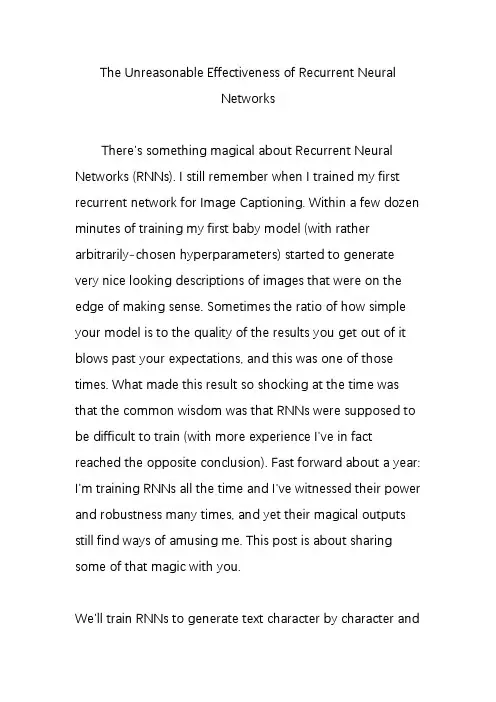
The Unreasonable Effectiveness of Recurrent NeuralNetworksThere's something magical about Recurrent Neural Networks (RNNs). I still remember when I trained my first recurrent network for Image Captioning. Within a few dozen minutes of training my first baby model (with rather arbitrarily-chosen hyperparameters) started to generate very nice looking descriptions of images that were on the edge of making sense. Sometimes the ratio of how simple your model is to the quality of the results you get out of it blows past your expectations, and this was one of those times. What made this result so shocking at the time was that the common wisdom was that RNNs were supposed to be difficult to train (with more experience I've in fact reached the opposite conclusion). Fast forward about a year: I'm training RNNs all the time and I've witnessed their power and robustness many times, and yet their magical outputs still find ways of amusing me. This post is about sharing some of that magic with you.We'll train RNNs to generate text character by characterand ponder the question "how is that even possible?"By the way, together with this post I am also releasing code on Github that allows you to train character-level language models based on multi-layer LSTMs. You give it a large chunk of text and it will learn to generate text like it one character at a time. You can also use it to reproduce my experiments below. But we're getting ahead of ourselves; What are RNNs anyway?Recurrent Neural NetworksSequences. Depending on your background you might be wondering: What makes Recurrent Networks so special? A glaring limitation of Vanilla Neural Networks (and also Convolutional Networks) is that their API is too constrained: they accept a fixed-sized vector as input (e.g. an image) and produce a fixed-sized vector as output (e.g. probabilities of different classes). Not only that: These models perform this mapping using a fixed amount of computational steps (e.g. the number of layers in the model). The core reason that recurrent nets are more exciting is that they allow us to operate over sequences of vectors: Sequences in the input, the output, or in the mostgeneral case both. A few examples may make this more concrete:Each rectangle is a vector and arrows represent functions (e.g. matrix multiply). Input vectors are in red, output vectors are in blue and green vectors hold the RNN's state (more on this soon). From left to right: (1) Vanilla mode of processing without RNN, from fixed-sized input tofixed-sized output (e.g. image classification). (2) Sequence output (e.g. image captioning takes an image and outputs a sentence of words). (3) Sequence input (e.g. sentiment analysis where a given sentence is classified as expressing positive or negative sentiment). (4) Sequence input and sequence output (e.g. Machine Translation: an RNN reads a sentence in English and then outputs a sentence in French). (5) Synced sequence input and output (e.g. video classification where we wish to label each frame of the video). Notice that in every case are no pre-specified constraints on the lengths sequences because the recurrent transformation (green) is fixed and can be applied as many times as we like.As you might expect, the sequence regime of operation is much more powerful compared to fixed networks that are doomed from the get-go by a fixed number of computational steps, and hence also much more appealing for those of us who aspire to build more intelligent systems. Moreover, as we'll see in a bit, RNNs combine the input vector with their state vector with a fixed (but learned) function to produce a new state vector. This can in programming terms be interpreted as running a fixed program with certain inputs and some internal variables. Viewed this way, RNNs essentially describe programs. In fact, it is known that RNNs are Turing-Complete in the sense that they can to simulate arbitrary programs (with proper weights). But similar to universal approximation theorems for neural nets you shouldn't read too much into this. In fact, forget I said anything.If training vanilla neural nets is optimization over functions, training recurrent nets is optimization over programs.Sequential processing in absence of sequences. Youmight be thinking that having sequences as inputs or outputs could be relatively rare, but an important point to realize is that even if your inputs/outputs are fixed vectors, it is still possible to use this powerful formalism to process them in a sequential manner. For instance, the figure below shows results from two very nice papers from DeepMind. On the left, an algorithm learns a recurrent network policy that steers its attention around an image; In particular, it learns to read out house numbers from left to right (Ba et al.). On the right, a recurrent network generates images of digits by learning to sequentially add color to a canvas (Gregor et al.):Left: RNN learns to read house numbers. Right: RNN learns to paint house numbers.The takeaway is that even if your data is not in form of sequences, you can still formulate and train powerful models that learn to process it sequentially. You're learning stateful programs that process your fixed-sized data.RNN computation. So how do these things work? At the core, RNNs have a deceptively simple API: They accept an input vector x and give you an output vector y. However,crucially this output vector's contents are influenced not only by the input you just fed in, but also on the entire history of inputs you've fed in in the past. Written as a class, the RNN's API consists of a single step function:rnn = RNN()y = rnn.step(x) # x is an input vector, y is the RNN's output vectorThe RNN class has some internal state that it gets to update every time step is called. In the simplest case this state consists of a single hidden vector h. Here is an implementation of the step function in a Vanilla RNN:class RNN:# ...def step(self, x):# update the hidden stateself.h = np.tanh(np.dot(self.W_hh, self.h) +np.dot(self.W_xh, x))# compute the output vectory = np.dot(self.W_hy, self.h)return yThe above specifies the forward pass of a vanilla RNN. This RNN's parameters are the three matrices W_hh,W_xh, W_hy. The hidden state self.h is initialized with the zero vector. The np.tanh function implements anon-linearity that squashes the activations to the range [-1, 1]. Notice briefly how this works: There are two terms inside of the tanh: one is based on the previous hidden state and one is based on the current input. In numpy np.dot is matrix multiplication. The two intermediates interact with addition, and then get squashed by the tanh into the new state vector. If you're more comfortable with math notation, we can also write the hidden state update as ht+1=tanh(Whhht+Wxhxt), where tanh is applied elementwise.We initialize the matrices of the RNN with random numbers and the bulk of work during training goes into finding the matrices that give rise to desirable behavior, as measured with some loss function that expresses your preference to what kinds of outputs y you'd like to see in response to your input sequences x.Going deep. RNNs are neural networks and everything works monotonically better (if done right) if you put on yourdeep learning hat and start stacking models up like pancakes. For instance, we can form a 2-layer recurrent network as follows:y1 = rnn1.step(x)y = rnn2.step(y1)In other words we have two separate RNNs: One RNN is receiving the input vectors and the second RNN is receiving the output of the first RNN as its input. Except neither of these RNNs know or care - it's all just vectors coming in and going out, and some gradients flowing through each module during backpropagation.Getting fancy. I'd like to briefly mention that in practice most of us use a slightly different formulation than what I presented above called a Long Short-Term Memory (LSTM) network. The LSTM is a particular type of recurrent network that works slightly better in practice, owing to its more powerful update equation and some appealing backpropagation dynamics. I won't go into details, but everything I've said about RNNs stays exactly the same, except the mathematical form for computing the update (the line self.h = ...) gets a little more complicated. Fromhere on I will use the terms "RNN/LSTM" interchangeably but all experiments in this post use an LSTM.Character-Level Language ModelsOkay, so we have an idea about what RNNs are, why they are super exciting, and how they work. We'll now ground this in a fun application: We'll train RNN character-level language models. That is, we'll give the RNN a huge chunk of text and ask it to model the probability distribution of the next character in the sequence given a sequence of previous characters. This will then allow us to generate new text one character at a time.As a working example, suppose we only had a vocabulary of four possible letters "helo", and wanted to train an RNN on the training sequence "hello". This training sequence is in fact a source of 4 separate training examples: 1. The probability of "e" should be likely given the context of "h", 2. "l" should be likely in the context of "he", 3. "l" should also be likely given the context of "hel", and finally 4. "o" should be likely given the context of "hell".Concretely, we will encode each character into a vector using 1-of-k encoding (i.e. all zero except for a single one at the index of the character in the vocabulary), and feedthem into the RNN one at a time with the step function. We will then observe a sequence of 4-dimensional output vectors (one dimension per character), which we interpret as the confidence the RNN currently assigns to each character coming next in the sequence. Here's a diagram:An example RNN with 4-dimensional input and output layers, and a hidden layer of 3 units (neurons). This diagram shows the activations in the forward pass when the RNN is fed the characters "hell" as input. The output layer contains confidences the RNN assigns for the next character (vocabulary is "h,e,l,o"); We want the green numbers to be high and red numbers to be low.For example, we see that in the first time step when the RNN saw the character "h" it assigned confidence of 1.0 to the next letter being "h", 2.2 to letter "e", -3.0 to "l", and 4.1 to "o". Since in our training data the next correct character is "e", we would want to increase its confidence (green) and decrease the confidence of all other letters (red). The most common approach is to use a cross-entropy lossfunction here, which corresponds to placing a Softmax classifier on every output vector, with the correct class being the index of the next character in the sequence. Once the loss is backpropagated and the RNN's weights are updated, the correct next letters will have higher scores when faced with similar inputs. Technical add: The RNN is trained with mini-batch Stochastic Gradient Descent. I like to use RMSProp (a per-parameter adaptive learning rate) to stablilize the updates.Notice also that the first time the character "l" is input, the target is "l", but the second time the target is "o。
全新版21世纪⼤学英语第三册课后段落英译汉ReadAloud)全新版21世纪⼤学英语第三册课后段落英译汉(Read Aloud)Unit 1Read Aloud英译汉Children especially are hungry for reassurance, and the want of kindly appreciation in childhood can endanger the growth of character. A young mother told the Reverend A. W. Beaven of a heart-aching in cident: “My little daughter often misbehaves and I have to rebuke her. But one day she had been especially good, hadn’t done a single thing that called for reprimand. That night, after I tucked her in bed and started downstairs, I heard her sobbing. Turning back, I found her head hidden in the pillow. Between sobs she asked, ‘Haven’t I been a pretty good girl today?’孩⼦们尤其渴望⿎励。
童年时如果得不到善意的赞赏,将会危及性格的发展。
⼀位年轻妈妈向A·W·⽐⽂牧师讲述了⼀件让⼈伤⼼的事:“我的⼩⼥⼉常常不听话,我不得不批评她。
但是有⼀天,她特别乖,没有做⼀件会挨批评的事。
当天晚上,我给她盖好被⼦、准备下楼时,听见她在抽泣。
我⾛回去,发现她把头埋在枕头⾥。
她⼀边呜咽⼀边问:‘难道我今天还不够乖吗?’”“That question,”said the mother, “went through me like a knife. I had been quick to correct her when she did wrong, but when she had tried to behave I had not noticed it. I had put her to bed without one word of appreciation.”“那个问题,”那位妈妈说,“像把⼑⼀样刺痛了我。
His July 2009 arrival at Old Trafford may have raised a few eyebrows, but former Liverpool striker Michael Owen is undoubtedly one of the finest goalscorers in the history of English football.The Chester-born forward notched up more than 200 goals for Liverpool, Real Madrid and Newcastle United, plus 40 goals in 89 England internationals prior to signing for Sir Alex Ferguson's men.Owen burst to prominence at his boyhood side, Liverpool, where he scored on his first-team debut aged just 17. His lightning pace, untraceable movement and clinical finishing made him a Premier League revelation, and it wasn’t long before hetook the international stage by storm.The 1998 World Cup in France was Michael’s springboard, as he scored an incredible solo goal in England’s second-round tie with Argentina. While red-carded United midfielder David Beckham became something of a scapegoat for the Three Lions’penalty shootout exit, Owen was hailed a national hero.His Liverpool career went from strength to strength, and in 2001 his part in the Merseysiders' triple cup haul of UEFA Cup, FA Cup and League Cup –together with international feats including a hat-trick against Germany –earned him the Ballon d’Or and FWA Player of the Year awards2009年7月,老特拉福德,欧文的到来可能会让一些人不认同,但前利物浦前锋欧文无疑是在英格兰足球历史上最优秀的射手之一。
词汇1They decided to perpetuate (使永存)the memory of their leader by erecting a statue.2After young people step into the society, they will be beset(被包围)with various temptations诱惑.3The gypsy girl swayed her hips in a sensuous(给人美感的)way as she danced.4The protestant提出异议的uttered发出的a few commonplace (平凡的事)about peace and democracy民主政体.5The elephant’s trunk is a unique form of appendage(附属肢体). 大象的鼻子是一种独特的附肢6By making a remark about the weather unobtrusively, she kept the conversation going.不唐突的7His Hamlet was a(an) revelation to the critics.启示8When little Tommy could not get his way, his behavior became perverse and contrary.任性,固执9Someone must have rummaged about among my papers, for my drawer is in a mess.到处翻寻xx必须有人翻遍了我的文件,我的抽屉里一团糟10When choosing a job, don’t be swayed just by promises of high earnings.摆动11You have to see these changes in contest: they’re part of a larger plan.上下文12She strongly denounced the government’s hypocrisy in dealing with the Israeli-Palestine issue.公开指责13He hopes to gain her favor by pandering to her desire for continuous praise.吸引14The rain sent all the farmers who were working in the fields scurrying for shelter.急跑15The police questioned the veracity of the suspect’s statement.真实性16Each morning the priest spent an hour in quiet contemplation.沉思17If one aids and abets a criminal, he is also considered culpable.该受责备的18To put it bluntly, this article is too verbose, we must edit it.坦率的,19Even though the evidence is overwhelming, if one juror is still skeptical, the case must be retried.怀疑的20Although we are in different parties, his ideas on politics are exactly in line with mine.相同21The report make out its case for increased spending on education.支持22Celebrated the world over for his writing, he still refused to put himself in the foreground.最显著的位置23Producers of pornographic material often claim that they are cater to a psychological need.迎合24By dint of sheer toughness and real courage, the expeditioners lived through the jungle difficulties and dangers.借助25“Could I impose on you for a little h elp with this letter? I don’t quite know the best way to phrase it without causing offense.”利用26Racial discrimination and injustice are ubiquitous and deeply ingrained in this country.根深蒂固27Compared with modern satellite dishes, ordinary TV aerials look positively antiquated.陈旧的28Common sense and creativity are some of the intangible we’re looking for in an employee.难以明了的29His parents had settled in the crowded ghettoes of the big city, surrounded by desperate poverty and anarchic violence.无政府主义30The Prime Minister had an in-depth exchange of views and reached broad agreement with his European counterpart on questions of protecting environment for human survival and combating international crimes.同伴31Graduates who intend to get on in state system have, in their own interests, to conform to the rules and take the additional one-year course that is provided for them.符合32Do you think that Joy will get the award for this year’s best fashion designer? She is hard working and able, but no genius.天赋33The new fashion soon lost its appeal, awaiting the next cycle.吸引力34Her pulse started throbing when she saw there were books scattered over the carpet and a bowl of roses was overturned.跳动35It was a large house containing a spacious sitting-room, four separate bedrooms and a communal kitchen.公用的36The big Yorkshire combine, John Smith’s Tadcaster brewery, was reported to merge with Warwick andRichardson, the brewers of Newark, Notts.合并37The increasing tempo of the new economic world could no longer afford to disperse with mechanics, hydrostatics, optics, navigation, etc.分配38This is an ambitious scheme to raise such a big sum of money in such a short time.计划39His reluctance to admit the failure outraged public opinion.暴行,侮辱,愤怒40In some ways it will be a testing occasion for him, although some think his position unassailable simply because there is no one else in sight to supplant him.排挤,取代41Rome was not built in a day: strongholds of tradition reinforce by stubborn religious conviction, often biased and prejudiced, could not be broken down in a moment.增强42All the publicity stunts in an advertising campaign were contrived to promote the sales of the products.设法,图谋43When truth is mingled with falsehood, truth is no longer taken as truth.混合44Equally important have been the Hobhouse journals, a vast mass of material partly in the British Museum ,partly in the possession of the Hobhouse family in Somerset.拥有45Well prepared and confident ,Tim appeared unabashed by all the media attention.沉着的,泰然自若的46The impact of computer has been likened to that of the printing press.把。
a rXiv:as tr o-ph/13125v28May21Accepted for publication in ApJ Letters Recurrent very-long type-I X-ray bursts in the low-mass X-ray binary 4U 1636–53Rudy Wijnands 1Center for Space Research,Massachusetts Institute of Technology,NE80-6055,77Massachusetts Avenue,Cambridge,MA 02139-4307,USA;rudy@ ABSTRACT Two flares with a duration of several hours are reported for the low-mass X-ray binary 4U 1636–53.The characteristics of these flares (i.e.,decay time scales,spectral softening,fluences)are very similar to the very long type-I X-ray bursts recently found in several other low-mass X-ray binaries,suggesting that the flares in 4U 1636–53are also very long type-I X-ray bursts.This would make this source the fifth to exhibit this phenomenon and the first one for which multiple bursts have been found.Interestingly,all five sources accrete at approximately 10%of the Eddington mass accretion rate.Although a chance coincidence or a selection effect cannot be ruled-out at present,this correlation is suggestive and might indicate that only at a narrow range of mass accretion rate such very long type-I X-ray bursts can occur.Subject headings:accretion,accretion disks —stars:individual (4U 1636–53)—X-rays:stars1.IntroductionType-I X-ray bursts in low-mass X-ray binary (LMXB)systems are thought to be due to thermonuclear flashes on the surfaces of neutron stars,which occur when the unstable burning of helium or hydrogen ignites the unburned matter on the surface of the neutron stars.These bursts are characterized by fast rise times (of order seconds),long decay times (seconds to minutes),spectral softening during the bursts,and recurrence times of hours to days.Also their X-ray spectra can usually very well be described by black-body radiation.The exact physics behind type-I X-ray bursts is very complex,but it is thought that the properties of the bursts are governed by the properties of the neutron star (radius,mass,magnetic field strength)and by the propertiesFig.1.—The1.5–12keV ASM light curve of4U1636–53showing the two very long X-ray events. of the accreted matter(accretion rate,composition of the material).For reviews about the X-raybursts and the physics involved see,e.g.,Lewin et al.(1993)and Bildsten(1998).In recent years,exciting new discoveries were reported concerning type-I X-ray bursts.Soon after the launch of the Rossi X-ray Timing Explorer(RXTE;Bradt,Rothschild,&Swank1993) at the end of1995,nearly coherent oscillations(called burst oscillations,with frequencies of300–600Hz)were found during the type-I X-ray bursts of several LMXBs(e.g.,Strohmayer et al. 1996).These burst oscillations are most likely due to the spin frequency of the neutron star(see Strohmayer2001for a review about burst oscillations),demonstrating that at least several LMXBs harbor rapidly spinning neutron stars as expected if the neutron star LMXBs are the progenitors of the millisecond radio pulsars.Cornelisse et al.(2000)reported an extremely long(hours)type-I X-ray burst(a“super-burst”)from4U1735–44using the Wide Field Camera(WFC)on board BeppoSAX.Such super-bursts have now also been reported in several other sources(4U1820–30: Strohmayer2000;KS1731–260and Serpens X-1;Heise,in’t Zand,&Kuulkers2000).The physics behind such super-bursts is not yet well-known,which is mostly due to the very recent discovery of such bursts and the limited information available for them.However,it was suggested that they are not regular hydrogen or heliumflashes,but due to unstable carbon burning(Strohmayer2000). Here,I present recurrent super-bursts from the LMXB4U1636–53as observed with the all sky monitor(ASM;Levine et al.1996)on board RXTE.2.The RXTE/ASM light curve of4U1636–53The RXTE/ASM light curve2of4U1636–53is shown in Figure1(up to2001March22,13:33 UTC).Clearly visible is the very recentflare-like event on2001Feb2217:10UTC(event2),just at the end of the light curve.Thisflare triggered this study and a close-up of it is shown in Figure2b. Clearly,the rise of thisflare is faster than the decay time.The ratio between the count rate in the range5–12keV and the one in the range1.5–3keV is given in Figure2d,which shows that theflux at the peak of the event is harder than the persistent emission but its spectrum softens considerably during the decay.As can been seen from Figure1,anotherflare-like event occurred prior to the2001Feb22 one on1996June1914:42UTC(event1),which is shown in detail in Figure2a.The event has a similar peak count rate,profile,and5–12keV/1.5–3keV count rate ratio(Fig.2c)as those of event2(Fig.2d).These similarities between the two events strongly suggest that they are due to the same physical mechanism,demonstrating that this behavior of4U1636–53is recurrent.The events werefitted with an exponential function in order to determine a characteristic decay time scale.The results are listed in Table1.Thefirst event likely has a longer duration (about twice as long)as the second event,although the sporadic sampling of the events with the RXTE/ASM might have artificially caused this effect.It is clear,however,that both events lasted more than one hour and possibly as long as three hours.The decay time for event2decreased with photon energy(Tab.1),which is consistent with the spectral softening of its spectrum during the decay(Fig.2b).The decay time for event1increases with photon energy,although the inverse cannot be excluded due to the large errors.A smaller decay time at higher energies(similar to that of event2)is more likely given the softening of the spectrum during the decay of event1.A detailed spectral analysis of the events is not possible due to the lack of energy resolution of the RXTE/ASM data(only three energy channels).Therefore,the total peak count rates of the events have been converted into aflux estimate using PIMMS3.As an input spectrum,a black-body was used with kT of2keV(see Cornelisse et al.2000for the temperature of the super-burst in 4U1735–44,and assuming the events in4U1636–53are super-bursts as claimed in section3)and a column density of4.7×1021cm−2(Schulz1999;note that due to the relative high energy of the first energy channel of the RXTE/ASM[1.5keV],theflux results are rather insensitive to the exact column density).The derived maximum unabsorbedfluxes at the peak of the events are2.4×10−8 erg s−1cm−2(1.5–12keV),which for a distance of5.9kpc(Augusteijn et al.1998)corresponds to a luminosity of1.0×1038erg s−1.This is only a lower limit to the peak luminosity;due to the erratic sampling by the RXTE/ASM the true peak might not have been observed.For the same reason,the totalfluences of the events are rather uncertain,but they are likely to be in the rangelc.html and is provided by the ASM/RXTE team3A web-based version of PIMMS is available at /Tools/w3pimms.htmlFig.2.—The1.5–12keV ASM light curve of4U1636–53for event1(a)and2(b),and the5–12 keV/1.5–3keV count rate curve of event1(c)and2(d).0.5–1×1042ergs.Apart from the two very obviousflares,the RXTE/ASM light curve of4U1636–53shows evidence for several smallerflares(Fig.1).For theseflares,no exponential decays nor a significant softening of the spectra are observed,although this might be due to the sampling of the RXTE/ASM data.It is unclear if(any of)those smallerflares are due to the same mechanism as the two large events discussed above.A possible alternative explanation is that these smallerflares are due to “normal”type-I X-ray bursts which happened to occur at the time that the source was observed with the RXTE/ASM.3.DiscussionTwoflares were found in the RXTE/ASM light curve of4U1636–53,with characteristic expo-nential decay profiles which last for several hours.The limited energy resolution of the RXTE/ASM data does not allow a detailed spectral analysis,but it is clear that during the decay theflares be-come considerably softer.The total peak luminosities andfluences are in the order of1038erg s−1and1042ergs,respectively.All these characteristics are very similar to similarflares found with the BeppoSAX/WFC for4U1735–44(Cornelisse et al.2000)and the RXTE proportional counter array(PCA)for4U1820–30(Strohmayer2000).Theseflares were interpreted as very long type-I X-ray bursts(“super-burst”).The similarities between those super-bursts and theflares observed for4U1636–53strongly suggest that the latter events are also super-bursts.This con-clusion is strengthened by the fact that during the second event,data were also obtained with the RXTE/PCA,which again suggests that thisflare is a super-burst(T.Strohmayer2001,private communication).These high time and spectral resolution RXTE/PCA data during this super-burst opens the exiting possibility of studying a second super-burst in great detail(after the one already reported for4U1820–30;Strohmayer2000).4U1636–53is thefifth source which exhibits such super-bursts,demonstrating that this phe-nomenon is common among the neutron star LMXBs.So far,4U1636–53is the only source for which more than one super-burst has been detected.Two clear super-bursts have been observed from this source,although some of the smallerflares might also be related to the super-burst phenomenon.Due to the erratic sampling of RXTE/ASM,it is also possible that several other super-bursts were missed.Therefore,the time span between the two super-bursts of4.7years reflects only an upper limit on the recurrence time of super-bursts in4U1636–53.Now,withfive sources which exhibit these super-bursts identified a remarkable trend is visible. Allfive sources are relatively bright,with a peak intrinsic luminosity of0.1–0.3times the Eddington luminosity(L E)for a1.4M⊙accreting neutron star.No neutron star LMXB with considerably higher(>0.5L E)or lower(<0.1L E)peak luminosity has(so far)shown a super-burst,although this might well be possible due to a chance coincidence or a selection effect.Due to the higher statistics, the brightness of the super-burst sources makes it easier to conclusive identify a possible super-burst with a real super-burst.However,this argument is invalid for the brightest neutron star LMXBs, for which even better statistics are available.Those systems already show less-normal type-I X-ray bursts,so the mechanism behind the suppression of the normal bursts might also suppress super-bursts.A quick-look of the RXTE/ASM light curves of the LMXBs currently monitored by RXTE did not reveal for those sources an obvious event like the super-bursts in4U1636–53.A more detailed analysis might reveal less obvious events,but such a study is beyond the scope of this paper.A detailed study of the RXTE/ASM light curves and/or the BeppoSAX/WFC of all the burst sources is necessary to perform a statistical analyses in order to accurately determine how significant the above noted correlation is.Although it cannot be excluded that the above correlation is due to chance coincidence or selection effects,it is also possible that this correlation is real and that only above a certain (averaged)mass accretion rate such bursts can occur.If true,then good candidates to also exhibit super-bursts would be the relatively bright neutron star LMXBs4U1728–34,4U1705–44,and4U 1702–42.The preliminary examination of their RXTE/ASM light curve did not reveal a convincing super-burst.However,this does not mean that they did not exhibit such burst or can exhibit them in the future,as the super-bursts reported in4U1735–44and4U1820–30are not present in the RXTE/ASM light curves of these sources due to the lack of coverage by the instrument at the time of the bursts.Furthermore,no obvious super-bursts are present in the RXTE/ASM light curves of KS1731–260and Serpens X-1(the times of the occurrence of the super-bursts in these sources have not been published yet),although a possible candidate super-burst occurred in KS1731–260 at1996Sep.2312:58UTC.However,the evidence is inconclusive(i.e.,no evidence for spectralsoftening is observed)so it is not possible to claim this event as a super-burst.The nature and the physics of super-bursts are not well-known,which is mostly due to the very recent discovery of such bursts and the limited amount of information available about them. Long type-I X-ray bursts were already investigated by Fujimoto et al.(1987),but they predicted that such very long bursts would only occur at an accretion rate below1%of the critical Eddington rate.However,as already pointed-out for4U1735–44by Cornelisse et al.(2000),allfive sources exhibiting super-bursts accrete well above this level.This discrepancy might be due to the fact that Fujimoto et al.(1987)only considered hydrogen and heliumflashes and not carbonflashes, which Strohmayer(2000)suggests as a mechanism for the super-burst in4U1820–30.He found that just prior to the super-burst in4U1820–30,a regular heliumflash occurred,demonstrating that a heliumflash nature for the super-burst in this source can be excluded,suggesting that the super-burst might be due to a carbonflash.Taam&Picklum(1978)studied carbonflashes and found that such bursts occur for accretion rates between10−10and10−9M⊙yr−1,which is only slightly lower than the accretion rates observed for thefive super-burst sources(see also Strohmayer 2000).However,Brown&Bildsten argued that only for pure helium accreting sources,enough car-bon is expected to remain available after normal type-I bursts,that a carbon burst could occur. Therefore,carbon bursts could explain the super-burst in4U1820–30,which has a white dwarf companion,but it less likely that they can explain the super-bursts in4U1636–53for which hydro-gen has been observed in its optical spectrum(see,e.g.,Canizares,McClintock,&Grindlay1979; Augusteijn et al.1998).More theoretical investigations are needed to determine if all super-bursts are due to carbonflashes or that a different mechanism is necessary for the super-bursts in certain sources.Instruments like the BeppoSAX/WFC and the RXTE/ASM are good to study many sources simultaneously to increase the chances of observing a super-burst,but they have limited capabil-ities(limited spectral and timing resolution and/or limited sensitivity).In order to get a better understanding of super-bursts,high resolution spectral instruments and/or high timing resolution instruments are necessary.However,due to the rarity of super-bursts such data are difficult to obtain.It is very fortunate that such data exist now,not only for the super-burst in4U1820–30 (Strohmayer2000),but also for one in4U1636–53(T.Strohmayer2001private communication).This work was supported by NASA through Chandra Postdoctoral Fellowship grant number PF9-10010awarded by CXC,which is operated by SAO for NASA under contract NAS8-39073. This research has made use of the quick-look results provided by the ASM/RXTE team.I thank Jon Miller,Tod Strohmayer,and Remon Cornelisse for helpful and insightful discussions.REFERENCESAugusteijn,T.,van der Hooft,F.,de Jong,J.A.,van Kerkwijk,M.H.,van Paradijs,J.1998,A&A, 332,561Bildsten,L.1998,in“The Many Faces of Neutron Stars”,eds. A.Alpar,L.Buccheri,&J.van Paradijs,NATO ASI,Kluwer,Dordrecht,p.419Bradt,H.V.,Rothschild,R.E.,&Swank,J.H.1993,A&AS,97,355Brown,E.F.&Bildsten,L.1998,ApJ,496,915Canizares,C.R.,McClintock,J.E.,&Grindlay,J.E.1979,ApJ,234,556Cornelisse,R.,Heise,J.,Kuulkers,E.,Verbunt,F.,in’t Zand,J.J.M.2000,A&A,357,L21 Fujimoto,M.,Hanawa,T.,Iben,I.,Richardson,M.1987,ApJ,315,198Heise,J.,in’t Zand,J.J.M.,Kuulkers E.2000,HEAD32,28.03Levine,A.M.,Bradt,H.,Cui,W.,Jernigan,J.G.,Morgan,E.H.,Remillard,R.,Shirey,R.E., Smith,D.A.1996,ApJ,469,L33Lewin,W.,van Paradijs,J.,Taam,R.1993,Sp.Sci.Rev.62,223Schulz,N.S.1999,ApJ,511,304Strohmayer,T.E.2000HEAD32,24.10Strohmayer,T.E.2001,Adv.Space.Research,in press(astro-ph/0012516)Strohmayer,T.E.,Zhang,W.,Swank,J.H.,Smale,A.,Titarchuk,L.,Day,C.1996,ApJ,469,L9 Taam,R.E.&Picklum R.E.1978,ApJ,224,210Table1.Event parametersTime of event a Peak count rate b Characteristic decay time scale(min)1996Jun1914:4264±2187+35−29158+130−72187±292001Feb2217:1062±288±7132+22−1968±6。